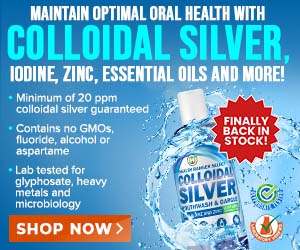
Artificial Blood Kills, but Manufacturer Pitches It as a Success
Tuesday, August 26, 2008 by: Heidi Stevenson
Tags: artificial blood, health news, Natural News
- The hidden war above: Chemtrails, HAARP and the battle for planetary control
- Florida Senate passes bill banning geoengineering and weather modification and Governor DeSantis has indicated it will become law
- Hidden toll: Federal secrecy shields wind industry's eagle deaths to protect land-hungry turbines that yield minimal power
- CLOT SHOT PLANDEMIC UNFOLDING: Fibrous, rubbery clots caused by covid injections have prion-like seeding activity
- 7 Must-have multi-functional survival tools for every prepper
- DEATH by VACCINE or face PRISON time: Canadian Freedom Convoy leaders CONVICTED for protesting forced vaccination during the Covid Plandemic
- Aerosolized bioweapons? Strange “diploid biomasses” falling out of the sky in Florida captured under the microscope
- George Floyd double standard: White 4.0 athlete slaughtered by Black teen-media silent
- Widespread social and economic unrest: Steve Quayle issues urgent financial warning of imminent asset collapse in new interview with Mike Adams
- Putin launches largest military call-up since 2011 amid escalating tensions
- Idaho Gov. Brad Little vetoes Medical Freedom Act
- Global pedophile ring “Kidflix” shut down in landmark Europol operation
- Chief Justice Roberts faces scrutiny over ties to anti-Trump legal strategist Norm Eisen
- The Trump effect: RECORD LOW in illegal border crossings signals a new era of border security
- ChatGPT’s cowardly DOUBLE STANDARD: Bowing before Islam while mocking Christianity
- Science unlocks nature’s potential: How natural compounds may support individuals with Autism Spectrum Disorder (ASD)
- Top German general admits that CONSCRIPTION is “absolutely” necessary to combat Russia
- Analysis: The coming economic collapse, a mass uprising and Trump's three secret weapons to halt the growing revolt
- Newly released JFK files reveal Pentagon's role in creating Lyme disease and covid in the same lab
- European Court of Justice: Healthcare professionals who promoted or administered COVID-19 vaccines are CRIMINALLY LIABLE for any harm caused
- Aerosolized bioweapons? Strange “diploid biomasses” falling out of the sky in Florida captured under the microscope
- Oncologist warns of ‘terrifyingly aggressive’ cancers in children, linked to immune suppression from COVID vaccines
- Britain’s descent into police state censorship: Parents raided for questioning their daughter’s school system online
- Analysis: The coming economic collapse, a mass uprising and Trump's three secret weapons to halt the growing revolt
- Utah governor allows ban on LGBT pride flags in public buildings and schools, will take effect without his signature
- Kiss Your Genetic Privacy Good-Bye! 23andMe Gets Green Light to Sell Your Intimate Genetic Details to Anyone They Want
- FBI imposed gag order on agents to silence Hunter Biden laptop truth before 2020 election, new chat logs reveal
- The Health Ranger releases “Vaccine Zombie” song and music video, using AI-animated zombies for the music video
- DARPA: The shadowy innovator behind the world’s most advanced military technologies
- Mike Adams releases country western hit single: Goin’ Back in Time is Comin’ Home
- “Project Aldrin”: Senate probes Meta's alleged censorship dealings with China
- When antibiotics are unavailable, natural ANTIMICROBIAL compounds become essential first line defenses against infection
- AI-powered forecasting model proves more accurate than traditional systems at predicting the weather
- German researchers find link between mRNA vaccines and GENETIC CHANGES that precede CANCER and AUTOIMMUNE DISORDERS
- Dr. Mary Talley Bowden drops bombshells about children being permanently damaged by mRNA jabs during Tucker Carlson interview
- Ancient kitchen secrets REVEALED: How garlic, ginger and green onions fight cancer and heart disease
- Newly released JFK files reveal Pentagon's role in creating Lyme disease and covid in the same lab
- California's social media censorship law struck down: A victory for free speech or a threat to online safety?
- The Health Ranger releases “Vaccine Zombie” song and music video, using AI-animated zombies for the music video
- Dr. Mike Yeadon releases 15-minute testimony - WATCH - about genocidal intent of COVID “vaccines”
- EPA advisor admits the agency is funneling billions to climate groups ahead of Trump’s return to White House
- Rep. Nancy Mace introduces bill to ban biological males from female facilities on federal property
- Florida takes a stand: DeSantis proposes permanent ban on mRNA vaccine mandates
- Sugarcane extract superior to cholesterol-lowering drugs?
- Survival 101: Effective EMF blocking techniques
- Mike Adams releases country western hit single: Goin’ Back in Time is Comin’ Home
- OpenAI whistleblower who dissented against how the company trained ChatGPT found dead
- Attorney and TikTok influencer explains how he was offered hundreds of dollars to make false claims about Trump, Republicans
- CONSERVATIVES SOUND THE ALARM: Big Pharma and the Left trying to force $32 billion money grab from America’s seniors into year-end spending deal
- Pilots report mysterious lights 'moving at extreme speeds' across Oregon skies
- Trump expected to choose Kelly Loeffler as his agriculture secretary even though she was caught INSIDER TRADING during COVID
- Marketing director responsible for WOKE Jaguar rebrand is also an LGBT activist who supports Black Lives Matter
- Unpacking the Lies That We’ve Been Fed – new song and music video released by Mike Adams, the Health Ranger
- Poll: Majority of Ukrainians want peace negotiations to end war with Russia
- Red Cross issues warning to stop blood plasma donations from vaccinated people
- Scientists confirm: GENIUS brain function can be spontaneously unleashed in humans without any apparent cause
- EPA advisor admits the agency is funneling billions to climate groups ahead of Trump’s return to White House
- HYSSOP: What research reveals about the health benefits of this ancient holy herb
- Two containers with completed ballots fall out of truck in Florida
- Fully vaccinated about to see “tsunami” of illness and death, warns virologist
- Global leaders unite to clamp down on “misinformation” with UN-backed Cascais Declaration
- BREAKING: 2025 NDAA authorizes mandatory military draft of WOMEN across America… as Pentagon pursues global NUCLEAR war with both Russia and China at the same time
- Newly released JFK files reveal Pentagon's role in creating Lyme disease and covid in the same lab
- Michael Yon warns of a ZIONIST TAKEOVER in Trump’s second administration
- BOMBSHELL: DNA testing kits are a SCAM to develop ethnic-specific bioweapons
- Ozempic and Wegovy weight loss drugs are injectable LIZARD VENOM PEPTIDES that may unleash a devastating wave of organ failure… side effects align with symptoms of SNAKE BITES
- The Health Ranger releases “Vaccine Zombie” song and music video, using AI-animated zombies for the music video
- Israeli soldiers accused of even more torture and abuse in the West Bank
- These 13 countries just signed an agreement to engineer a global FAMINE by destroying food supply
- NASA admits that climate change occurs because of changes in Earth’s solar orbit, and NOT because of SUVs and fossil fuels
- RFK Jr. clears key hurdle: Sen. Susan Collins backs controversial HHS nominee, signaling a new era for health policy
- Sermon 30: How Jesus reveals Caesar’s FAKE CURRENCY and FALSE AUTHORITY
* The death rate was 1-2/3 times higher in those who received artificial blood.
* Adverse events were 1-1/2 times higher in those who received artificial blood.
* Serious adverse events were 1-2/5 times higher in those who received artificial blood.
* Double the number of heart attacks occurred in those who received artificial blood.
* The number of strokes cannot be given a statistical outcome, because six people who received artificial blood had strokes, while there were no strokes in the control group.
Are your eyes spinning? Is your mouth hanging open in shock? Do you think there must have been a misprint? Is it possible that 1-2/3 more deaths, double the number of heart attacks, an infinitely higher rate of strokes, and more adverse events can be considered successful?
The answer, when you're a pharmaceutical corporation trying to make profits, is an unequivocal yes. Biopure is trying to get Hemopure, a hemoglobin-based oxygen carrier (HBOC) intended to replace blood in transfusions, approved for sale. To this end, on June 10th, it produced a press release quoting the company's medical vice president, Dr. A. Gerson Greenburg, as saying, "It is gratifying to have experts cull through the complex data repeatedly until insight into our product emerged."
If you translate that statement, what you have is a claim that even the worst results can be ignored in favor of a carefully defined definition of success that fits a portion of the data.
My Approach to the Study
As a result of my recent Natural News article, "Disaster Results From Artificial Blood Testing on Unsuspecting People" (https://www.naturalnews.com/023353.html) , I was included in mailings by Biopure. The first complained of the Natanson study referenced in the article, claiming that it was a "poorly constructed meta-analysis predicated on the hypothesis of an increased mortality".
The author, A. Gerson Greenburg, MD, Vice President of Medical Affairs, further stated, "In my opinion, it would be in the best interest of science and the field that both publications be formally retracted from the literature and an apology issued for being inaccurate, erroneous, incorrect, improper and unjust." Strong words!
Biopure has sent out notices of a new trial of their artificial blood product, Hemopure. They quickly blanketed the online finance world with notifications of it and claims of both its efficacy and safety. The same article, word-for-word, appeared on sites all over the 'net.
My approach was different. I looked for the study itself. Unable to find it, I contacted Biopure and asked for a copy. Within ten minutes, I had it. Unlike all those publications and their so-called reporters, who simply took the word of the pharmaceutical company and printed what they sent without a second look, I have read and carefully reviewed the study itself
So, you can be among the first to know what the study actually says.
Conflicts of Interest
The study, "HBOC-201 as an Alternative to Blood Transfusion: Efficacy and Safety Evaluation in a Multicenter Phase III Trial in Elective Orthopedic Surgery" was published in the June issue of the Journal of Trauma. (HBOC is an acronym for hemoglobin based oxygen carrier.)
One of the authors is Greenburg, Biopure's medical vice president. The lead author is Jonathan S. Jahr, MD. As a stockholder in Biopure, Jahr has a financial interest in the results of the study. He has previously published a study that withheld data showing negative results.
In 2004, a lawsuit was filed against Biopure for misleading investors for misrepresenting Hemopure's safety after it knew that the FDA had misgivings about it. They settled out of court. Several other class action suits have been filed against Biopure.
How can results like these be reported as successful?
Different techniques were used to obfuscate the recent trial's results:
* Implying that, because it was already known that the product causes certain adverse events, then those particular effects could be ignored as not relevant.
* Specifying success as avoidance of real blood transfusion in a certain percentage of cases, ignoring negative results in patients.
* Identifying the subset of patients with the worst results and placing the blame on their characteristics.
Study Methodology
The Subjects
Orthopedic patients having a wide range of surgeries were used in the study of Biopure's HBOC as the subjects. There were 693 subjects in 46 locations around the world, including the U.S., Europe, Canada, and South Africa. 350 were in the HBOC (artificial blood) group, and 338 were in the packed red blood cell (PRBC) control group. Types of surgery were all related to the skeletal joint system. 304 of the HBOC group and 282 of the PRBC group underwent non-back surgery. 46 of the HBOC group and 48 of the PRBC group underwent back surgery.
The trial ran for six weeks. There was no long term follow-up.
Reasons for doing HBOC or PRBC infusions included:
* Heart rate over 100 beats per minute
* Low systolic blood pressure
* Evidence of myocardial ischemia in an ECG
* Acidosis
* Blood loss over 7 milliliters/kilogram
* Diminished urine output less than 0.5 milliliters/kilogram/hour
* Weakness or dizziness
The Study
If certain criteria were met, those who had been given HBOC (artificial blood) were given PRBC (real blood). These were patients whose condition was not being adequately helped by HBOC. Thus, the goal of the study was to limit the percentage of cases in which PRBC was required. Success was defined as avoiding PRBC infusion in 35% of subjects. The study reports that over 50% of the HBOC group were able to avoid PRBC infusions. This is the basis of the claim for success.
Subjects deemed to require a transfusion were given either HBOC or PRBC by randomization. Some patients who were started on HBOC were later switched to PRBC "based on the investigator's assessment of clinical need," according to the study. How this determination was made was not discussed, though it was claimed that "contemporary transfusion process" was adhered to.
Each of the two groups of subjects were divided into two more groups. Those who were given HBOC (artificial blood) were divided according to whether they were switched to PRBC. Those who were given PRBC only were divided according to whether they were given two or fewer units of blood or three or more units.
Subjects who were started on HBOC and never received PRBC were considered moderate risk. Those who were started on PRBC and received fewer than three units were also considered moderate risk. Those who were started on HBOC and switched to PRBC were considered high risk. Those who were started on PRBC and received three or more units were considered high risk.
Several markers for health were tracked in the subjects. These include creatinine, hemoglobin levels, systolic blood pressure, lipase, and liver function tests. There was discussion about whether adverse events were associated with various test results. HBOC had a negative impact on all these markers. Positive or negative, they do not have any bearing on the claim of efficacy for Biopure's artificial blood, though they may be indicative of why there were so many more adverse events with it.
Results
Results from the four groups were discussed extensively in the study report. The study stated that nearly all of the negative results were in the high risk groups. This is hardly surprising, especially in light of the fact that the results of the study determined which subjects were classed as high risk.
Being switched from HBOC to PRBC, or being given more than two transfusions in those started on PRBC, were the only determinants of high risk classification. There is no way to identify high risk, other than by treatment. Thus, this separation into smaller groups accomplishes nothing but obfuscation.
The authors identified those at greatest risk as being over age 80. They make this claim based on 43% of cardiac severe adverse events and half of the deaths being in this group, though they are only 9% of the total number of subjects. While this is interesting, it does not include all adverse events.
Were those who suffered strokes the same age, or were they, perhaps, two decades younger? That information is not provided. So, very little can be concluded about the relative risk of artificial blood based on age.
Yes, it's interesting that 43% of severe cardiac events were among people over age 80. However, the ages of the rest of the subjects who suffered from cardiac events is not noted. Neither are the ages of the stroke victims given. Nor the ages associated with any other adverse events. In fact, what is most notable here is the lack of information provided.
The authors state:
"There are a number of physiologic effects of HBOC-201 that are known and expected for this class of drugs... removal of these expected AEs [adverse events] reduced the difference between matching groups... and clearly accounted for the majority of the differences between groups."
From a patient's point of view -- and, one would hope, that of a doctor -- the fact that adverse events are known to occur in a class of drugs does not eliminate them from concern.
The authors blame over and under treatment for a large portion of adverse events. What determines whether a patient has been over or under treated is not defined, making it a questionable piece of information.
The authors show a significant decrease in the use of their artificial blood product. They don't, though, state what basis, other than "contemporary transfusion process" was used to determine when or why real blood needed to be used instead.
Implications
If those who are at high risk could be identified before being subjected to artificial blood, then the study might be considered successful. However, the only determinants for high risk were the results of the study -- those who required a switch from HBOC to PRBC or those who required three or more units of PRBC. So, the bottom line for any potential patient is whether there is greater risk from artificial blood than real blood. The answer to that was quite clearly delineated by the study. Yes, severe risks, including death, are greatly increased by Biopure's product, Hemopure.
No amount of obfuscation or discussion of whether a patient was medium or high risk changes that fact. From the point of view of most patients, success is not measured by whether real blood transfusions are avoided. What counts is the likelihood of encountering an adverse event, like heart attack or stroke, or dying. If that risk is greater with Biopure's product, then most patients will not want it used.
References:
"HBOC-201 as an Alternative to Blood Transfusion: Efficacy and Safety Evaluation in a Multicenter Phase III Trial in Elective Orthopedic Surgery", The Journal of Trauma, Jonathan S. Jahr, MD, Colin Mackenzie, MD, L. Bruce Pearce, PhD, Arkadiy Pitman, MS, & A. Gerson Greenburg, MD, PhD
"Artificial Blood: HBOC-201 Does Well in Clinical Trial", Scientific Blogging, (http://www.scientificblogging.com/news_relea...)
Berman DeValerio Pease, Tabacco, Burt & Pucillo, "Biopure Corp.", (http://www.bermanesq.com/Securities/CasePage...)
About the author
* Heidi Stevenson, BSc, DIHom, FBIH* Fellow, British Institute of Homeopathy
* Gaia Health (http://www.gaia-health.com)
*
* The author is a homeopath who became concerned with medically-induced harm as a result of her own experiences and those of family members. She says that allopathic medicine is the arena that best describes the motto, "Buyer beware."
*
*
* Heidi Stevenson provides information about medically-induced disease and disability, along with incisive well-researched articles on major issues in the modern world, so members of the public can protect themselves.
*
She can be reached through her website: www.gaia-health.com
Artificial blood at FETCH.news
Get independent news alerts on natural cures, food lab tests, cannabis medicine, science, robotics, drones, privacy and more.
Take Action: Support Natural News by linking to this article from your website
Permalink to this article:
Embed article link: (copy HTML code below):
Reprinting this article:
Non-commercial use OK, cite NaturalNews.com with clickable link.
Follow Natural News on Facebook, Twitter, Google Plus, and Pinterest
Science News & Studies
Medicine News and Information
Food News & Studies
Health News & Studies
Herbs News & Information
Pollution News & Studies
Cancer News & Studies
Climate News & Studies
Survival News & Information
Gear News & Information
News covering technology, stocks, hackers, and more



"Big Tech and mainstream media are constantly trying to silence the independent voices that dare to bring you the truth about toxic food ingredients, dangerous medications and the failed, fraudulent science of the profit-driven medical establishment.
Email is one of the best ways to make sure you stay informed, without the censorship of the tech giants (Google, Apple, Facebook, Twitter, YouTube, etc.). Stay informed and you'll even likely learn information that may help save your own life."
–The Health Ranger, Mike Adams












































